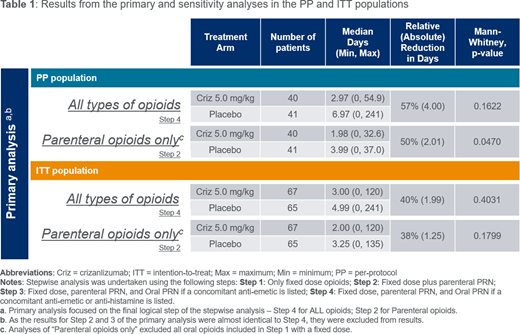OBJECTIVES: Vaso-occlusion is a hallmark feature of sickle cell disease (SCD) that promotes ischemia-reperfusion injury and leads to acute pain episodes, known as vaso-occlusive crises (VOCs). VOCs are disabling and frequently impact on the ability of the patient to attend work or school and participate in activities of daily living. VOCs are the primary reason for medical facility visits amongst SCD patients and are associated with increased morbidity and mortality. The acute pain of a VOC often requires parenteral opioid administration in hospital emergency departments and inpatient units. Patients are also frequently prescribed oral opioids to aid in home management of VOCs. The development of new SCD therapies that have been shown to reduce or prevent VOCs has generated interest in their potential as opioid sparing agents. This study evaluated the effect of crizanlizumab-a humanized monoclonal antibody indicated in the US for reduction of VOCs in SCD-on opioid use for managing VOC related pain.
METHODS: In this post hoc analysis, subject-level data from the SUSTAIN (NCT01895361) trial were analyzed to determine the number of days of opioid use by patients in both the 5.0 mg/kg crizanlizumab and placebo arms during the 52-week follow-up period. Opioid use captured in case report forms was retrospectively assessed. Due to the common use of "as needed" (PRN) dosing for analgesics, a decision tree was developed in conjunction with clinical advice to guide classification of the opioid as being taken or not taken on a given day based on clinically plausible assumptions. Assumptions considered dose frequency (fixed vs. PRN), route of administration (parenteral vs. oral), and concomitant medications (anti-emetics and anti-histamines).
Opioid record start dates, end dates, and dose frequencies were used to determine the number of unique days during the trial that each patient had taken at least one opioid. The annualized days with opioid use was calculated for each patient by dividing their number of unique days on opioids by their duration (days) in the trial. The distribution of annualized days with opioid use was compared between patients from the 5.0 mg/kg crizanlizumab and placebo arms. Mann-Whitney U tests with p-values were used to test differences between arms. A four-step analysis was planned to incorporate an increasing number of assumptions to define whether the opioid had been taken on a given day (see footnote of Table 1). Analyses were performed primarily in the per-protocol (PP) population considering all routes of administration and parenteral use only. Outcomes in the intention-to-treat (ITT) population were also assessed.
RESULTS: The PP population included 40 patients in the 5.0 mg/kg crizanlizumab arm and 41 patients in the placebo arm. A comparison of the baseline demographics (age, sex, genotype, hydroxyurea use, crisis frequency, and opioid use) showed no statistically significant differences between the two arms. Results of the final step of each analysis are presented as the primary analysis (see Table 1); results of Step 1 were considered a sensitivity analysis (not shown). The median annualized days with opioid use in the PP population was lower in the crizanlizumab arm compared with the placebo arm (absolute reduction: 4.00 days; relative reduction: 57%; p=0.162). The median annualized days with parenteral opioid use was lower in the crizanlizumab arm compared with the placebo arm (absolute reduction: 2.01; relative reduction: 50%; p=0.047). Results in the ITT population (see Table 1) and for sensitivity analyses (not shown) showed similar trends of reduced annualized days with opioid use for patients in the crizanlizumab group compared to the placebo group.
CONCLUSIONS: These findings indicate that crizanlizumab, compared with placebo, may reduce the annual number of days where opioids are used to manage pain from VOCs. Importantly, the benefit was observed for parenteral and oral opioids, demonstrating clinical and patient relevance. These findings are concordant with the tendency for crizanlizumab to reduce the number of VOCs experienced by SCD patients annually; the primary finding of the SUSTAIN trial. The reduction in opioid use with crizanlizumab requires exploration in future studies, but the findings of this study translate into positive clinical and patient-relevant outcomes beyond reducing the frequency of VOCs.
Smith:Shire: Research Funding; Imara: Research Funding; Novo Nordisk: Consultancy; Ironwood: Consultancy; Pfizer: Consultancy; Incyte: Other: Investigator; Health Resources and Services Administration: Other: Investigator, Research Funding; Patient-Centered Outcomes Research Institute: Other: Investigator, Research Funding; NHLBI: Research Funding; Shire, Inc.: Other: Investigator, Research Funding; Global Blood Therapeutics, Inc.: Consultancy, Research Funding; Novartis, Inc.: Consultancy, Other: Investigator, Research Funding; Emmaeus Pharmaceuticals, Inc.: Consultancy; GlycoMimetics, Inc.: Consultancy. Ataga:Bioverativ: Honoraria, Membership on an entity's Board of Directors or advisory committees; Shire/Takeda: Research Funding; Editas Medicine: Honoraria; Global Blood Therapeutics: Honoraria, Membership on an entity's Board of Directors or advisory committees, Research Funding; Pfizer: Research Funding; Forma Therapeutics: Consultancy; Modus Therapeutics: Honoraria; Novo Nordisk: Honoraria, Membership on an entity's Board of Directors or advisory committees; Novartis: Consultancy, Honoraria, Research Funding. Saraf:Global Blood Therapeutics: Membership on an entity's Board of Directors or advisory committees, Other: Advisory Boards, Speakers Bureau; Novartis, Global Blood Therapeutics: Membership on an entity's Board of Directors or advisory committees; Pfizer, Global Blood Therapeutics, Novartis: Research Funding. Adisa:Novartis Pharmaceuticals Corporation: Current Employment. Bailey:Novartis Pharmaceuticals Corporation: Current Employment. Ramscar:Novartis Pharma AG: Current Employment. Bonner:Eversana: Current Employment. Brown:Eversana: Current Employment. Pastor:Eversana: Current Employment.
Author notes
Asterisk with author names denotes non-ASH members.


This feature is available to Subscribers Only
Sign In or Create an Account Close Modal